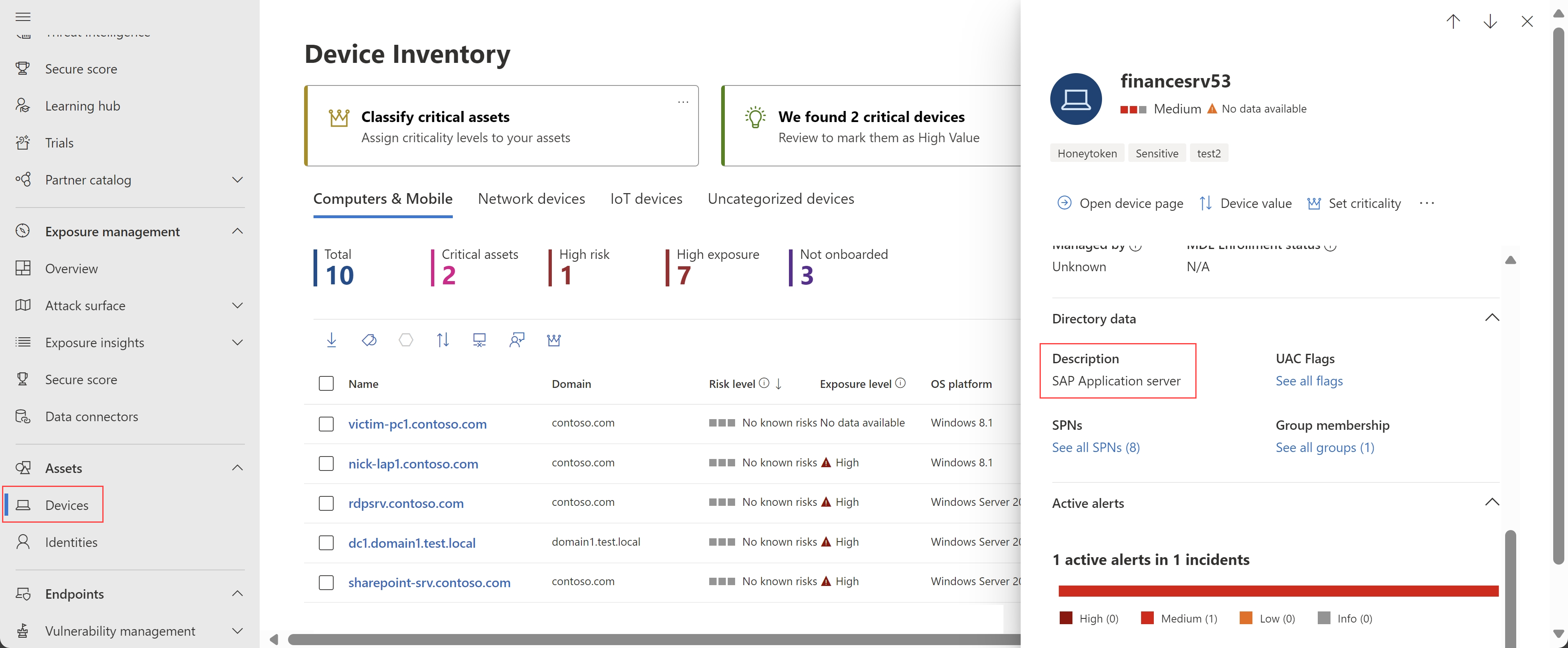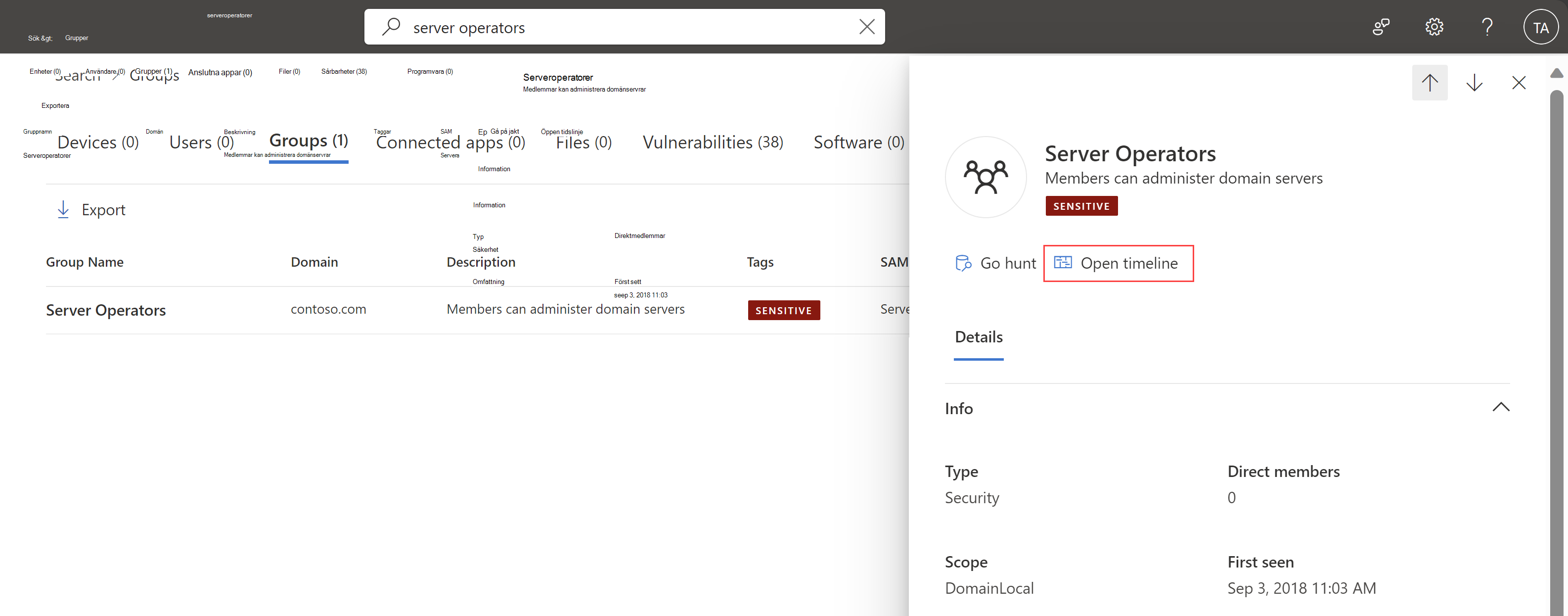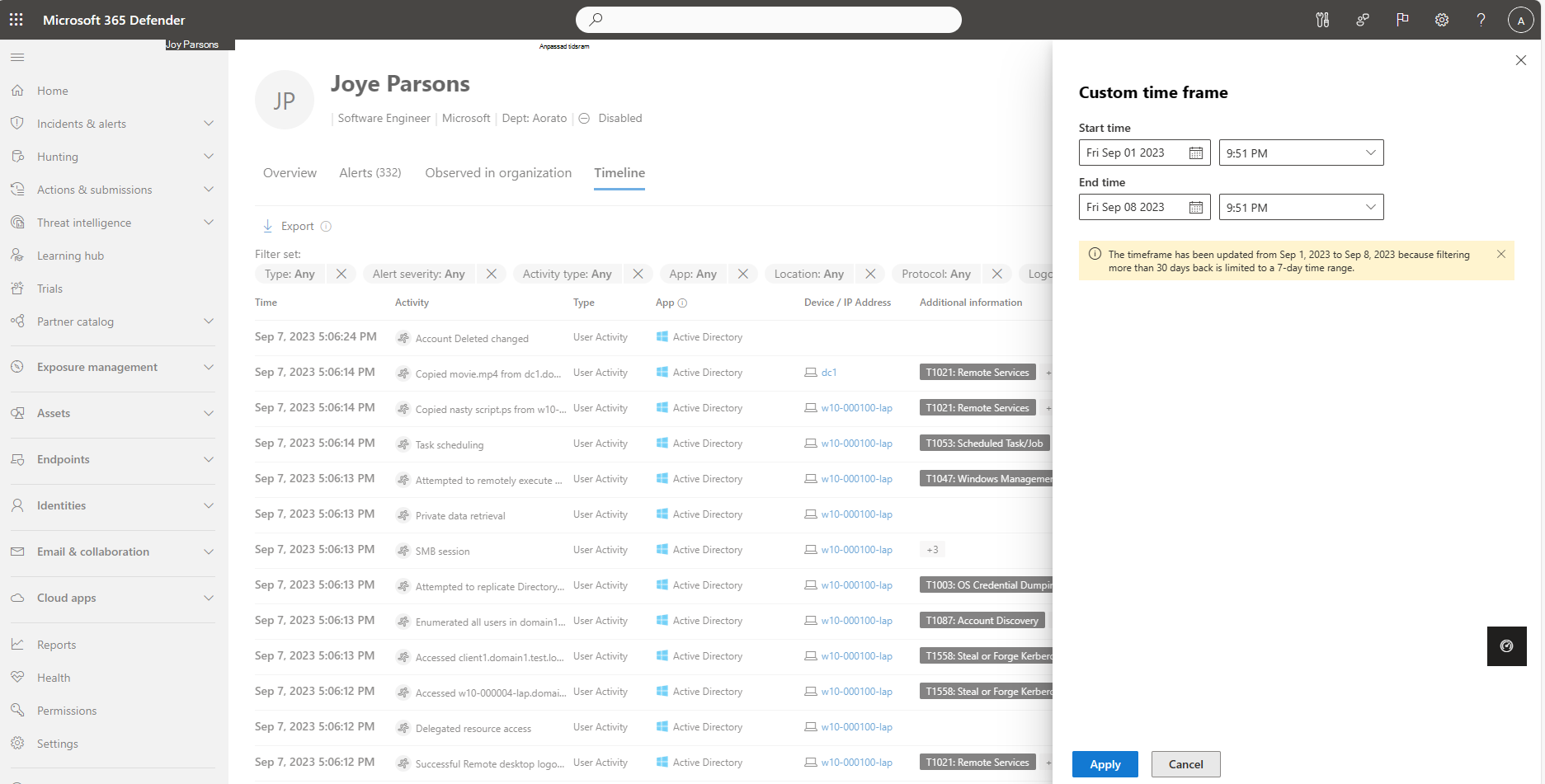Nyheter i Microsoft Defender for Identity
Den här artikeln uppdateras ofta för att informera dig om vad som är nytt i de senaste versionerna av Microsoft Defender for Identity.
Vad är nytt omfång och referenser
Defender for Identity-versioner distribueras gradvis mellan kundklientorganisationer. Om det finns en funktion dokumenterad här som du inte ser ännu i din klientorganisation kan du komma tillbaka senare för uppdateringen.
Mer information finns i:
- Nyheter i Microsoft Defender XDR
- Senaste nytt i Microsoft Defender för Endpoint
- Nyheter i Microsoft Defender for Cloud Apps
Uppdateringar om versioner och funktioner som släpptes för sex månader sedan eller tidigare finns i Det nya arkivet för Microsoft Defender for Identity.
Mars 2025
Nya LDAP-frågehändelser har lagts till i tabellen IdentityQueryEvents i Avancerad jakt
Nya LDAP-frågehändelser har lagts till IdentityQueryEvents i tabellen i Avancerad jakt för att ge mer insyn i ytterligare LDAP-sökfrågor som körs i kundmiljön.
Februari 2025
Uppdateringar av DefenderForIdentity PowerShell-modulen (version 1.0.0.3)
Nya funktioner och förbättringar:
- Stöd för att hämta, testa och ställa in Papperskorgen för Active Directory i Get/Set/Test MDIConfiguration.
- Stöd för att hämta, testa och ställa in proxykonfigurationen på den nya MDI-sensorn.
- Active Directory Certificate Services-registervärdet för granskningsfiltrering anger nu typen korrekt.
- New-MDIConfigurationReport visar nu namnet på det testade grupprincipobjektet och stöder server- och identitetsargument.
Felkorrigeringar:
- Förbättrad tillförlitlighet för Containerbehörigheter för DeletedObjects på icke-engelska operativsystem.
- Åtgärdade onödiga utdata för att skapa KDS-rotnyckeln.
- Andra tillförlitlighetskorrigeringar.
Fliken Nya attackvägar på sidan Identitetsprofil
Den här fliken ger insyn i potentiella angreppsvägar som leder till en kritisk identitet eller involverar den inom sökvägen, vilket hjälper till att utvärdera säkerhetsrisker. Mer information finns i Översikt över attackväg i Exponeringshantering.
Ytterligare förbättringar av identitetssidan:
Ny sidopanel med mer information för varje post på användarens tidslinje.
Filtreringsfunktioner på fliken Enheter under Observerad i organisationen.
Uppdatera rekommendationen "Skydda och hantera lokala administratörslösenord med Microsoft LAPS"
Den här uppdateringen justerar utvärderingen av säkerhetsstatusen i Säkerhetspoäng med den senaste versionen av Windows LAPS, vilket säkerställer att den återspeglar aktuella rekommenderade säkerhetsmetoder för hantering av lokala administratörslösenord.
Nya och uppdaterade händelser i tabellen Advanced hunting IdentityDirectoryEvents
Vi har lagt till och uppdaterat följande händelser i tabellen IdentityDirectoryEvents i Avancerad jakt:
Kontrollflaggan för användarkontot har ändrats
Skapa säkerhetsgrupp i Active Directory
Det gick inte att ändra ett kontolösenord
Lyckad ändring av kontolösenord
Kontots primära grupp-ID har ändrats
Dessutom har den inbyggda schemareferensen för Avancerad jakt i Microsoft Defender XDR uppdaterats så att den innehåller detaljerad information om alla händelsetyper som stöds (ActionType värden) i identitetsrelaterade tabeller, vilket ger fullständig insyn i tillgängliga händelser. Mer information finns i Avancerad information om jaktschema.
Januari 2025
Ny identitetsguide
Utforska viktiga MDI-funktioner med den nya identitetsturnén i M365-portalen. Navigera till Incidenter, Jakt och Inställningar för att förbättra identitetssäkerhet och hotundersökning.
December 2024
Ny utvärdering av säkerhetsstatus: Förhindra certifikatregistrering med godtyckliga programprinciper (ESC15)
Defender for Identity har lagt till den nya rekommendationen Förhindra certifikatregistrering med godtyckliga programprinciper (ESC15) i Microsoft Secure Score.
Den här rekommendationen tar direkt upp den nyligen publicerade CVE-2024-49019, som belyser säkerhetsrisker i samband med sårbara AD CS-konfigurationer. Den här utvärderingen av säkerhetsstatus visar en lista över alla sårbara certifikatmallar som finns i kundmiljöer på grund av icke-mönstret ad CS-servrar.
Den nya rekommendationen läggs till i andra AD CS-relaterade rekommendationer. Tillsammans erbjuder dessa utvärderingar säkerhetsstatusrapporter som visar säkerhetsproblem och allvarliga felkonfigurationer som medför risker för hela organisationen, tillsammans med relaterade identifieringar.
Mer information finns i:
Säkerhetsutvärdering: Förhindra certifikatregistrering med godtyckliga programprinciper (ESC15)
Microsoft Defender for Identity säkerhetsstatusutvärderingar
Oktober 2024
MDI utökar täckningen med nya 10 rekommendationer för identitetsstatus (förhandsversion)
De nya utvärderingarna av identitetssäkerhetsstatus (ISPM: er) kan hjälpa kunder att övervaka felaktig konfiguration genom att titta efter svaga punkter och minska risken för potentiella attacker på den lokala infrastrukturen.
Dessa nya identitetsrekommendationer, som en del av Microsoft Secure Score, är nya säkerhetsstatusrapporter relaterade till Active Directory-infrastruktur och grupprincipobjekt:
Ändra det gamla lösenordet för domänkontrollantens datorkonto
GPO tilldelar icke-privilegierade identiteter till lokala grupper med förhöjd behörighet
Dessutom uppdaterade vi den befintliga rekommendationen "Ändra oskyddade Kerberos-delegeringar för att förhindra personifiering" för att inkludera indikation på Kerberos-begränsad delegering med protokollövergång till en privilegierad tjänst.
Augusti 2024
Ny Microsoft Entra Connect-sensor:
Som en del av vårt pågående arbete med att förbättra Microsoft Defender for Identity täckning i hybrididentitetsmiljöer har vi introducerat en ny sensor för Microsoft Entra Connect-servrar. Dessutom har vi släppt nya hybridsäkerhetsidentifieringar och nya rekommendationer för identitetsstatus specifikt för Microsoft Entra Connect, vilket hjälper kunderna att hålla sig skyddade och minska potentiella risker.
Nya rekommendationer för Microsoft Entra Anslut identitetsstatus:
-
Rotera lösenord för Microsoft Entra Connect Connector-konto
- Ett komprometterat Microsoft Entra Connect Connector-konto (AD DS-anslutningskonto, som ofta visas som MSOL_XXXXXXXX) kan ge åtkomst till funktioner med hög behörighet som replikering och lösenordsåterställning, vilket gör det möjligt för angripare att ändra synkroniseringsinställningar och äventyra säkerheten i både molnmiljöer och lokala miljöer samt erbjuda flera sökvägar för att kompromettera hela domänen. I den här utvärderingen rekommenderar vi att kunderna ändrar lösenordet för MSOL-konton med det lösenord som senast angavs för över 90 dagar sedan. Klicka här om du vill ha mer information.
-
Ta bort onödiga replikeringsbehörigheter för Microsoft Entra Connect-konto
- Som standard har Microsoft Entra Connect-anslutningskontot omfattande behörigheter för att säkerställa korrekt synkronisering (även om de faktiskt inte krävs). Om synkronisering av lösenordshash inte har konfigurerats är det viktigt att ta bort onödiga behörigheter för att minska risken för angrepp. Klicka här om du vill ha mer information
-
Ändra lösenord för Microsoft Entra sömlös SSO-kontokonfiguration
- Den här rapporten visar alla Microsoft Entra sömlösa SSO-datorkonton med lösenord som senast angavs för över 90 dagar sedan. Lösenordet för Azure SSO-datorkontot ändras inte automatiskt var 30:e dag. Om en angripare komprometterar det här kontot kan de generera tjänstbiljetter för AZUREADSSOACC-kontot åt alla användare och personifiera alla användare i Microsoft Entra klientorganisation som synkroniseras från Active Directory. En angripare kan använda detta för att flytta i efterhand från Active Directory till Microsoft Entra ID. Klicka här om du vill ha mer information.
Nya Microsoft Entra Connect-identifieringar:
-
Misstänkt interaktiv inloggning till Microsoft Entra Connect-servern
- Direktinloggningar till Microsoft Entra Connect-servrar är mycket ovanliga och potentiellt skadliga. Angripare riktar ofta in sig på dessa servrar för att stjäla autentiseringsuppgifter för bredare nätverksåtkomst. Microsoft Defender for Identity kan nu identifiera onormala inloggningar till Microsoft Entra Connect-servrar, vilket hjälper dig att identifiera och reagera snabbare på dessa potentiella hot. Det är specifikt tillämpligt när Microsoft Entra Connect-servern är en fristående server och inte fungerar som domänkontrollant.
-
Återställning av användarlösenord av Microsoft Entra Connect-konto
- Microsoft Entra Connect-anslutningskontot har ofta hög behörighet, inklusive möjligheten att återställa användarens lösenord. Microsoft Defender for Identity har nu insyn i dessa åtgärder och identifierar all användning av de behörigheter som identifierades som skadliga och icke-legitima. Den här aviseringen utlöses endast om funktionen för tillbakaskrivning av lösenord är inaktiverad.
-
Misstänkt tillbakaskrivning av Microsoft Entra Connect på en känslig användare
- Även om Microsoft Entra Connect redan förhindrar tillbakaskrivning för användare i privilegierade grupper, utökar Microsoft Defender for Identity det här skyddet genom att identifiera ytterligare typer av känsliga konton. Den här förbättrade identifieringen hjälper till att förhindra obehöriga lösenordsåterställningar på kritiska konton, vilket kan vara ett viktigt steg i avancerade attacker som riktar sig mot både molnbaserade och lokala miljöer.
Ytterligare förbättringar och funktioner:
- Ny aktivitet för misslyckad lösenordsåterställning på ett känsligt konto som är tillgängligt i tabellen "IdentityDirectoryEvents" i Avancerad jakt. Detta kan hjälpa kunder att spåra misslyckade lösenordsåterställningshändelser och skapa anpassad identifiering baserat på dessa data.
- Förbättrad noggrannhet för identifiering av DC-synkroniseringsattacker .
- Nytt hälsoproblem för fall där sensorn inte kan hämta konfigurationen från Microsoft Entra Connect-tjänsten.
- Utökad övervakning för säkerhetsaviseringar, till exempel PowerShell Remote Execution Detector, genom att aktivera den nya sensorn på Microsoft Entra Connect-servrar.
PowerShell-modulen DefenderForIdentity har uppdaterats
PowerShell-modulen DefenderForIdentity har uppdaterats och innehåller nya funktioner och åtgärdar flera felkorrigeringar. Viktiga förbättringar är:
-
Ny
New-MDIDSACmdlet: Förenklar skapandet av tjänstkonton, med en standardinställning för grupphanterade tjänstkonton (gMSA) och ett alternativ för att skapa standardkonton. - Automatisk PDCe-identifiering: Förbättrar tillförlitligheten för att skapa grupprincip objekt (GPO) genom att automatiskt rikta in sig på den primära domänkontrollantens emulator (PDCe) för de flesta Active Directory-åtgärder.
-
Manuell målinriktning för domänkontrollant: Ny serverparameter för
Get/Set/Test-MDIConfigurationcmdletar, så att du kan ange en domänkontrollant för mål i stället för PDCe.
Mer information finns i:
- DefenderForIdentity PowerShell-modul (PowerShell-galleriet)
- Referensdokumentation för DefenderForIdentity PowerShell
Juli 2024
6 Nya identifieringar är nya i offentlig förhandsversion:
-
Möjlig NetSync-attack
- NetSync är en modul i Mimikatz, ett verktyg efter exploatering, som begär lösenordshash för en målenhets lösenord genom att låtsas vara en domänkontrollant. En angripare kan utföra skadliga aktiviteter i nätverket med hjälp av den här funktionen för att få åtkomst till organisationens resurser.
-
Eventuellt övertagande av ett Microsoft Entra sömlöst SSO-konto
- Ett Microsoft Entra sömlöst SSO-kontoobjekt (enkel inloggning), AZUREADSSOACC, ändrades misstänkt. En angripare kanske flyttar i efterhand från den lokala miljön till molnet.
-
Misstänkt LDAP-fråga
- En misstänkt LDAP-fråga (Lightweight Directory Access Protocol) som är associerad med ett känt attackverktyg upptäcktes. En angripare kanske utför rekognosering för senare steg.
-
Misstänkt SPN har lagts till i en användare
- Ett misstänkt namn på tjänstens huvudnamn (SPN) har lagts till i en känslig användare. En angripare kan försöka få förhöjd åtkomst för lateral förflyttning inom organisationen
-
Misstänkt skapande av ESXi-grupp
- En misstänkt VMWare ESXi-grupp skapades i domänen. Detta kan tyda på att en angripare försöker få fler behörigheter för senare steg i en attack.
-
Misstänkt ADFS-autentisering
- Ett domänanslutet konto som loggas in med Active Directory Federation Services (AD FS) (ADFS) från en misstänkt IP-adress. En angripare kan ha stulit en användares autentiseringsuppgifter och använder dem för att flytta åt sidan i organisationen.
Defender for Identity version 2.238
Den här versionen innehåller förbättringar och felkorrigeringar för molntjänster och Defender for Identity-sensorn.
Juni 2024
Sök enkelt efter användarinformation från ITDR-instrumentpanelen
Shield Widget ger en snabb översikt över antalet användare i hybridmiljöer, molnmiljöer och lokala miljöer. Den här funktionen innehåller nu direktlänkar till Advanced Hunting-plattformen, som erbjuder detaljerad användarinformation nära till hands.
Hälsowidgeten för ITDR-distribution innehåller nu Microsoft Entra villkorlig åtkomst och Microsoft Entra privatåtkomst
Nu kan du visa licenstillgängligheten för villkorlig åtkomst för Microsoft Entra arbetsbelastning, Microsoft Entra villkorsstyrd åtkomst för användare och Microsoft Entra privatåtkomst.
Defender for Identity version 2.237
Den här versionen innehåller förbättringar och felkorrigeringar för molntjänster och Defender for Identity-sensorn.
Maj 2024
Defender for Identity release 2.236
Den här versionen innehåller förbättringar och felkorrigeringar för molntjänster och Defender for Identity-sensorn.
Defender for Identity release 2.235
Den här versionen innehåller förbättringar och felkorrigeringar för molntjänster och Defender for Identity-sensorn.
April 2024
Identifiera enkelt CVE-2024-21427 Windows Kerberos Säkerhetsfunktion – Kringgå sårbarhet
För att hjälpa kunderna att bättre identifiera och identifiera försök att kringgå säkerhetsprotokoll enligt den här säkerhetsrisken har vi lagt till en ny aktivitet i Avancerad jakt som övervakar Kerberos AS-autentisering.
Med dessa data kan kunder nu enkelt skapa egna anpassade identifieringsregler i Microsoft Defender XDR och automatiskt utlösa aviseringar för den här typen av aktivitet
Åtkomst Defender XDR portal –> Jakt –> Avancerad jakt.
Nu kan du kopiera vår rekommenderade fråga enligt nedan och klicka på "Skapa identifieringsregel". Tänk på att vår angivna fråga även spårar misslyckade inloggningsförsök, vilket kan generera information som inte är relaterad till en potentiell attack. Därför kan du anpassa frågan så att den passar dina specifika krav.
IdentityLogonEvents
| where Application == "Active Directory"
| where Protocol == "Kerberos"
| where LogonType in("Resource access", "Failed logon")
| extend Error = AdditionalFields["Error"]
| extend KerberosType = AdditionalFields['KerberosType']
| where KerberosType == "KerberosAs"
| extend Spns = AdditionalFields["Spns"]
| extend DestinationDC = AdditionalFields["TO.DEVICE"]
| where Spns !contains "krbtgt" and Spns !contains "kadmin"
| project Timestamp, ActionType, LogonType, AccountUpn, AccountSid, IPAddress, DeviceName, KerberosType, Spns, Error, DestinationDC, DestinationIPAddress, ReportId
Defender for Identity release 2.234
Den här versionen innehåller förbättringar och felkorrigeringar för molntjänster och Defender for Identity-sensorn.
Defender for Identity version 2.233
Den här versionen innehåller förbättringar och felkorrigeringar för molntjänster och Defender for Identity-sensorn.
Mars 2024
Nya skrivskyddade behörigheter för att visa Inställningar för Defender för identitet
Nu kan du konfigurera Defender för identitetsanvändare med skrivskyddade behörigheter för att visa Inställningar för Defender för identitet.
Mer information finns i Nödvändiga behörigheter Defender för identitet i Microsoft Defender XDR.
Nytt Graph-baserat API för att visa och hantera hälsoproblem
Nu kan du visa och hantera Microsoft Defender for Identity hälsoproblem via Graph API
Mer information finns i Hantera hälsoproblem via Graph API.
Defender for Identity release 2.232
Den här versionen innehåller förbättringar och felkorrigeringar för molntjänster och Defender for Identity-sensorn.
Defender for Identity release 2.231
Den här versionen innehåller förbättringar och felkorrigeringar för molntjänster och Defender for Identity-sensorn.
Februari 2024
Defender for Identity release 2.230
Den här versionen innehåller förbättringar och felkorrigeringar för molntjänster och Defender for Identity-sensorn.
Ny utvärdering av säkerhetsstatus för osäker AD CS IIS-slutpunktskonfiguration
Defender for Identity har lagt till den nya rekommendationen Redigera osäkra ADCS-certifikatregistrerings-IIS-slutpunkter (ESC8) i Microsoft Secure Score.
Active Directory Certificate Services (AD CS) stöder certifikatregistrering via olika metoder och protokoll, inklusive registrering via HTTP med hjälp av certifikatregistreringstjänsten (CES) eller gränssnittet för webbregistrering (Certsrv). Osäkra konfigurationer av IIS-slutpunkterna CES eller Certsrv kan skapa säkerhetsrisker för reläattacker (ESC8).
Den nya rekommendationen Redigera osäkra ADCS-certifikatregistrerings-IIS-slutpunkter (ESC8) läggs till i andra AD CS-relaterade rekommendationer som nyligen släpptes. Tillsammans erbjuder dessa utvärderingar säkerhetsstatusrapporter som visar säkerhetsproblem och allvarliga felkonfigurationer som medför risker för hela organisationen, tillsammans med relaterade identifieringar.
Mer information finns i:
- Säkerhetsutvärdering: Redigera osäkra ADCS-certifikatregistrerings-IIS-slutpunkter (ESC8)
- Utvärderingar av säkerhetsstatus för AD CS-sensorer
- Microsoft Defender for Identity säkerhetsstatusutvärderingar
Defender for Identity version 2.229
Den här versionen innehåller förbättringar och felkorrigeringar för molntjänster och Defender for Identity-sensorn.
Förbättrad användarupplevelse för att justera tröskelvärden för aviseringar (förhandsversion)
Sidan Avancerade inställningar för Defender för identitet har nu bytt namn till Justera tröskelvärden för aviseringar och ger en uppdaterad upplevelse med förbättrad flexibilitet för att justera tröskelvärden för aviseringar.
Ändringarna omfattar:
Vi har tagit bort det tidigare alternativet Ta bort utbildningsperiod och lagt till ett nytt alternativ för rekommenderat testläge . Välj Rekommenderat testläge för att ange alla tröskelvärden till Låg, öka antalet aviseringar och ange alla andra tröskelvärden till skrivskyddade.
Den tidigare kolumnen Känslighetsnivå har nu bytt namn till Tröskelvärdesnivå, med nyligen definierade värden. Som standard är alla aviseringar inställda på ett högt tröskelvärde, vilket representerar standardbeteendet och en standardaviseringskonfiguration.
I följande tabell visas mappningen mellan tidigare värden på känslighetsnivå och de nya värdena för tröskelvärden :
| Känslighetsnivå (tidigare namn) | Tröskelvärdesnivå (nytt namn) |
|---|---|
| Normal | Högsta |
| Medel | Medel |
| Högsta | Låg |
Om du har definierat specifika värden på sidan Avancerade inställningar har vi överfört dem till den nya sidan Justera tröskelvärden för aviseringar på följande sätt:
| Sidkonfiguration för avancerade inställningar | Ny sidkonfiguration för justera aviseringströsklar |
|---|---|
| Växlingsknapp för att ta bort inlärningsperiod |
Rekommenderat testläge har inaktiverats. Konfigurationsinställningarna för aviseringströskeln förblir desamma. |
| Ta bort inlärningsperiod inaktiverad |
Rekommenderat testläge har inaktiverats. Konfigurationsinställningarna för aviseringströskeln återställs till standardvärdena, med en hög tröskelnivå. |
Aviseringar utlöses alltid omedelbart om alternativet Rekommenderat testläge har valts, eller om en tröskelvärdesnivå är inställd på Medel eller Låg, oavsett om aviseringens inlärningsperiod redan har slutförts.
Mer information finns i Justera tröskelvärden för aviseringar.
Sidorna med enhetsinformation innehåller nu enhetsbeskrivningar (förhandsversion)
Microsoft Defender XDR innehåller nu enhetsbeskrivningar i enhetsinformationsfönster och enhetsinformationssidor. Beskrivningarna fylls i från enhetens Active Directory-beskrivningsattribut .
I sidofönstret med enhetsinformation kan du till exempel:
Mer information finns i Undersökningssteg för misstänkta enheter.
Defender for Identity version 2.228
Den här versionen innehåller förbättringar och felkorrigeringar för molntjänster och Defender for Identity-sensorn och följande nya aviseringar:
- Kontouppräkningsspaning (LDAP) (externt ID 2437) (förhandsversion)
- Lösenordsändring för återställningsläge för katalogtjänster (externt ID 2438) (förhandsversion)
Januari 2024
Defender for Identity version 2.227
Den här versionen innehåller förbättringar och felkorrigeringar för molntjänster och Defender for Identity-sensorn.
Fliken Tidslinje har lagts till för gruppentiteter
Nu kan du visa entitetsrelaterade aktiviteter och aviseringar för Active Directory-grupper från de senaste 180 dagarna i Microsoft Defender XDR, till exempel ändringar av gruppmedlemskap, LDAP-frågor och så vidare.
Om du vill komma åt gruppens tidslinjesida väljer du Öppna tidslinje i fönstret gruppinformation.
Till exempel:
Mer information finns i Undersökningssteg för misstänkta grupper.
Konfigurera och verifiera din Defender for Identity-miljö via PowerShell
Defender for Identity stöder nu den nya DefenderForIdentity PowerShell-modulen, som är utformad för att hjälpa dig att konfigurera och validera din miljö för att arbeta med Microsoft Defender for Identity.
Använda PowerShell-kommandon för att undvika felkonfigurationer och spara tid och undvika onödig belastning på systemet.
Vi har lagt till följande procedurer i dokumentationen för Defender for Identity som hjälper dig att använda de nya PowerShell-kommandona:
- Ändra proxykonfiguration med PowerShell
- Konfigurera, hämta och testa granskningsprinciper med PowerShell
- Generera en rapport med aktuella konfigurationer via PowerShell
- Testa dina DSA-behörigheter och delegeringar via PowerShell
- Testa tjänstanslutningen med PowerShell
Mer information finns i:
- DefenderForIdentity PowerShell-modul (PowerShell-galleriet)
- Referensdokumentation för DefenderForIdentity PowerShell
Defender for Identity version 2.226
Den här versionen innehåller förbättringar och felkorrigeringar för molntjänster och Defender for Identity-sensorn.
Defender for Identity version 2.225
Den här versionen innehåller förbättringar och felkorrigeringar för molntjänster och Defender for Identity-sensorn.
December 2023
Obs!
Om du ser ett minskat antal aviseringar om fjärrkörningsförsök kan du läsa våra uppdaterade septembermeddelanden, som innehåller en uppdatering av identifieringslogik för Defender för identitet. Defender for Identity fortsätter att registrera fjärrkörningsaktiviteterna för kod som tidigare.
Nytt identitetsområde och instrumentpanel i Microsoft 365 Defender (förhandsversion)
Defender for Identity-kunder har nu ett nytt identitetsområde i Microsoft 365 Defender för information om identitetssäkerhet med Defender för identitet.
I Microsoft 365 Defender väljer du Identiteter för att se någon av följande nya sidor:
Instrumentpanel: Den här sidan visar grafer och widgetar som hjälper dig att övervaka aktiviteter för identifiering och svar av identitetshot. Till exempel:

Mer information finns i Arbeta med Defender för identitetens ITDR-instrumentpanel.
Hälsoproblem: Den här sidan flyttas från området Inställningar > identiteter och listar eventuella aktuella hälsoproblem för din allmänna Defender för identitetsdistribution och specifika sensorer. Mer information finns i Microsoft Defender for Identity problem med sensorhälsa.
Verktyg: Den här sidan innehåller länkar till användbar information och resurser när du arbetar med Defender för identitet. På den här sidan hittar du länkar till dokumentation, särskilt om kapacitetsplaneringsverktyget och Test-MdiReadiness.ps1 skriptet.
Defender for Identity release 2.224
Den här versionen innehåller förbättringar och felkorrigeringar för molntjänster och Defender for Identity-sensorn.
Utvärderingar av säkerhetsstatus för AD CS-sensorer (förhandsversion)
Defender for Identitys säkerhetsstatusutvärderingar identifierar och rekommenderar proaktivt åtgärder i dina lokal Active Directory konfigurationer.
Rekommenderade åtgärder omfattar nu följande nya säkerhetsstatusutvärderingar, särskilt för certifikatmallar och certifikatutfärdare.
Rekommenderade åtgärder för certifikatmallar:
- Förhindra att användare begär ett certifikat som är giltigt för godtyckliga användare baserat på certifikatmallen (ESC1)
- Redigera övergiven certifikatmall med privilegierad EKU (Valfritt syfte EKU eller Ingen EKU) (ESC2)
- Felkonfigurerad certifikatmall för registreringsagenten (ESC3)
- Redigera felkonfigurerade certifikatmallar ACL (ESC4)
- Redigera felkonfigurerade certifikatmallar ägare (ESC4)
Rekommenderade åtgärder för certifikatutfärdare:
De nya utvärderingarna är tillgängliga i Microsoft Secure Score, som visar säkerhetsproblem och allvarliga felkonfigurationer som utgör risker för hela organisationen, tillsammans med identifieringar. Poängen uppdateras därefter.
Till exempel:
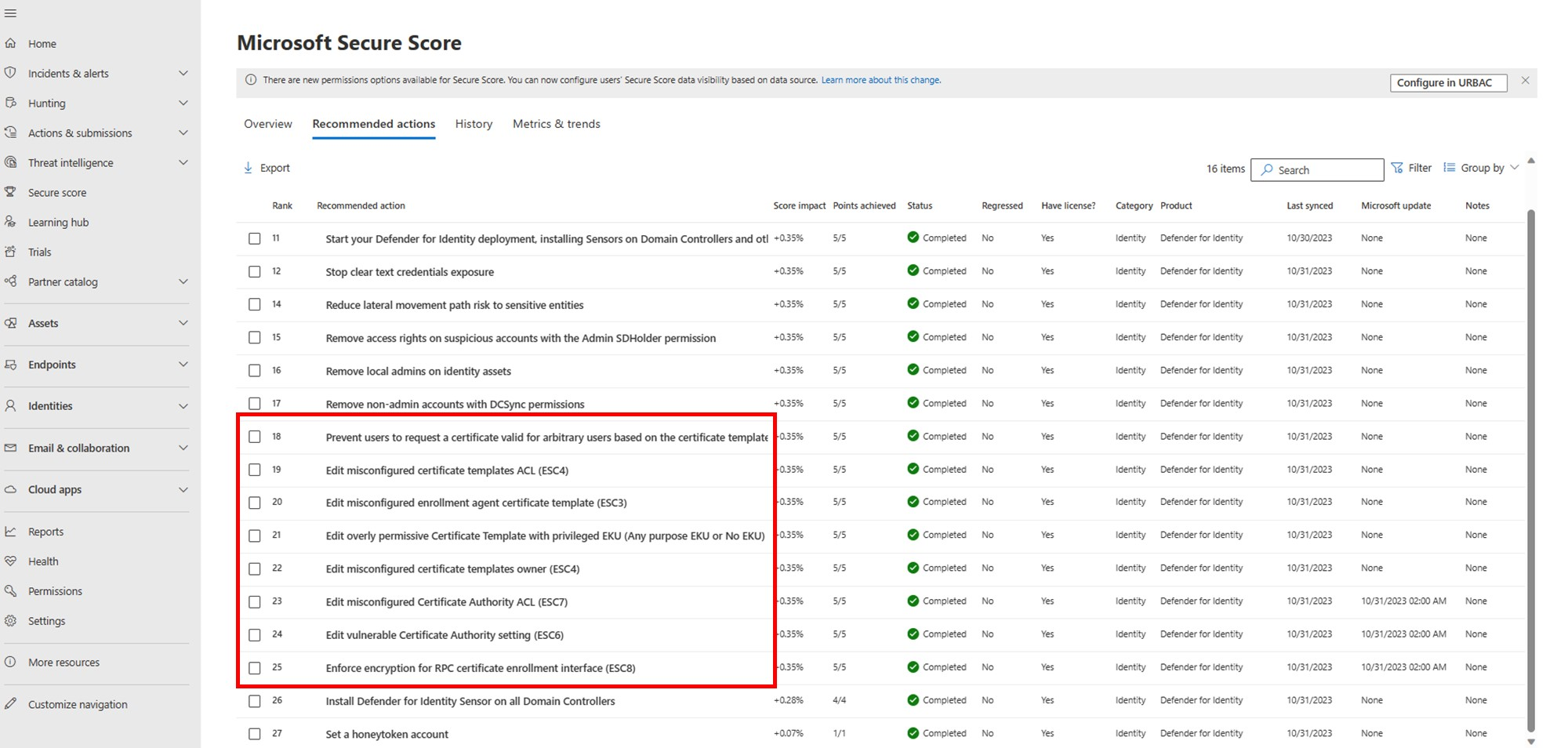
Mer information finns i Microsoft Defender for Identity säkerhetsstatusutvärderingar.
Obs!
Utvärderingar av certifikatmallar är tillgängliga för alla kunder som har AD CS installerat i sin miljö, men certifikatutfärdarutvärderingar är endast tillgängliga för kunder som har installerat en sensor på en AD CS-server. Mer information finns i Ny sensortyp för Active Directory Certificate Services (AD CS).
Defender for Identity version 2.223
Den här versionen innehåller förbättringar och felkorrigeringar för molntjänster och Defender for Identity-sensorn.
Defender for Identity version 2.222
Den här versionen innehåller förbättringar och felkorrigeringar för molntjänster och Defender for Identity-sensorn.
Defender for Identity version 2.221
Den här versionen innehåller förbättringar och felkorrigeringar för molntjänster och Defender for Identity-sensorn.
November 2023
Defender for Identity version 2.220
Den här versionen innehåller förbättringar och felkorrigeringar för molntjänster och Defender for Identity-sensorn.
Defender for Identity version 2.219
Den här versionen innehåller förbättringar och felkorrigeringar för molntjänster och Defender for Identity-sensorn.
Tidslinje för identiteter innehåller mer än 30 dagars data (förhandsversion)
Defender for Identity distribuerar gradvis utökade datakvarhållningar för identitetsinformation till mer än 30 dagar.
Fliken Tidslinje för identitetsinformation, som innehåller aktiviteter från Defender för identitet, Microsoft Defender for Cloud Apps och Microsoft Defender för Endpoint, innehåller för närvarande minst 150 dagar och växer. Det kan finnas en viss variation i datakvarhållningsfrekvensen under de närmaste veckorna.
Om du vill visa aktiviteter och aviseringar på identitetens tidslinje inom en viss tidsram väljer du standardvärdet 30 dagar och väljer sedan Anpassat intervall. Filtrerade data från för mer än 30 dagar sedan visas i högst sju dagar i taget.
Till exempel:
Mer information finns i Undersöka tillgångar och Undersöka användare i Microsoft Defender XDR.
Defender for Identity version 2.218
Den här versionen innehåller förbättringar och felkorrigeringar för molntjänster och Defender for Identity-sensorn.
Oktober 2023
Defender for Identity version 2.217
Den här versionen innehåller följande förbättringar:
Sammanfattningsrapport: Sammanfattningsrapporten uppdateras så att den innehåller två nya kolumner på fliken Hälsoproblem :
- Information: Ytterligare information om problemet, till exempel en lista över påverkade objekt eller specifika sensorer där problemet uppstår.
- Rekommendationer: En lista över rekommenderade åtgärder som kan vidtas för att lösa problemet eller hur du undersöker problemet ytterligare.
Mer information finns i Ladda ned och schemalägga Defender for Identity-rapporter i Microsoft Defender XDR (förhandsversion).
Hälsoproblem: Växlingsknappen "Ta bort inlärningsperiod" stängdes av automatiskt för det här klientorganisationens* hälsoproblem.
Den här versionen innehåller även felkorrigeringar för molntjänster och Defender for Identity-sensorn.
Defender for Identity release 2.216
Den här versionen innehåller förbättringar och felkorrigeringar för molntjänster och Defender for Identity-sensorn.
September 2023
Minskat antal aviseringar för körningsförsök för fjärrkod
För att bättre justera Defender för identitet och Microsoft Defender för Endpoint aviseringar uppdaterade vi identifieringslogik för identifieringslogik för identifiering av körningsförsök för Defender för identitet fjärrkod.
Den här ändringen resulterar i ett minskat antal aviseringar om fjärrkörningsförsök , men Defender for Identity fortsätter att registrera aktiviteter för körning av fjärrkod. Kunder kan fortsätta att skapa egna avancerade jaktfrågor och skapa anpassade identifieringsprinciper.
Inställningar för aviseringskänslighet och förbättringar av inlärningsperiod
Vissa Defender for Identity-aviseringar väntar under en inlärningsperiod innan aviseringar utlöses, samtidigt som du skapar en profil med mönster som ska användas när du skiljer mellan legitima och misstänkta aktiviteter.
Defender for Identity tillhandahåller nu följande förbättringar för inlärningsperioden:
Administratörer kan nu använda inställningen Ta bort inlärningsperiod för att konfigurera känsligheten som används för specifika aviseringar. Definiera känsligheten som Normal för att konfigurera inställningen Ta bort inlärningsperiod som Av för den valda typen av avisering.
När du har distribuerat en ny sensor i en ny Arbetsyta för Defender för identitet aktiveras inställningen Ta bort utbildningsperiod automatiskt i 30 dagar. När 30 dagar har slutförts stängs inställningen Ta bort inlärningsperiod automatiskt av och känslighetsnivåerna för aviseringar återgår till standardfunktionen.
Om du vill att Defender för identitet ska använda standardfunktioner för utbildningsperiod, där aviseringar inte genereras förrän inlärningsperioden är klar, konfigurerar du inställningen Ta bort inlärningsperioder till Av.
Om du tidigare hade uppdaterat inställningen Ta bort utbildningsperiod förblir inställningen som du hade konfigurerat den.
Mer information finns i Avancerade inställningar.
Obs!
Sidan Avancerade inställningar listade ursprungligen aviseringen om kontouppräkningsrekognosering under alternativen Ta bort inlärningsperiod som konfigurerbara för känslighetsinställningar. Den här aviseringen togs bort från listan och ersätts av LDAP-aviseringen (Security Principal Reconnaissance). Det här användargränssnittsfelet åtgärdades i november 2023.
Defender for Identity version 2.215
Den här versionen innehåller förbättringar och felkorrigeringar för molntjänster och Defender for Identity-sensorn.
Defender for Identity-rapporter flyttas till huvudområdet Rapporter
Nu kan du komma åt Defender for Identity-rapporter från Microsoft Defender XDR huvudområdet Rapporter i stället för området Inställningar. Till exempel:
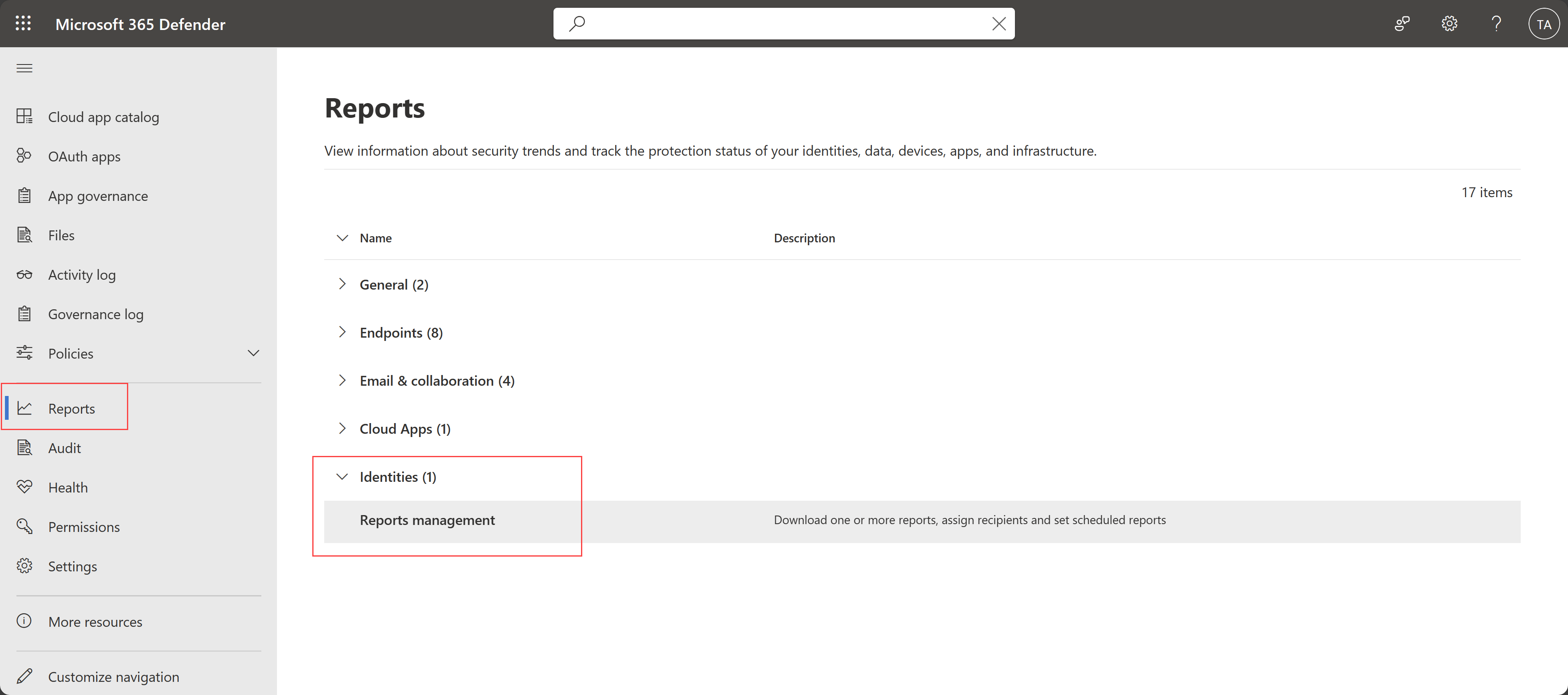
Mer information finns i Ladda ned och schemalägga Defender for Identity-rapporter i Microsoft Defender XDR (förhandsversion).
Knappen Gå till jakt för grupper i Microsoft Defender XDR
Defender for Identity har lagt till knappen Go hunt för grupper i Microsoft Defender XDR. Användare kan använda knappen Gå jakt för att fråga efter grupprelaterade aktiviteter och aviseringar under en undersökning.
Till exempel:

Mer information finns i Snabbt jaga efter entitets- eller händelseinformation med go hunt.
Defender for Identity release 2.214
Den här versionen innehåller förbättringar och felkorrigeringar för molntjänster och Defender for Identity-sensorn.
Prestandaförbättringar
Defender for Identity har gjort interna förbättringar för svarstid, stabilitet och prestanda vid överföring av realtidshändelser från Defender för identitetstjänster till Microsoft Defender XDR. Kunder bör inte förvänta sig några fördröjningar i Defender för identitetsdata som visas i Microsoft Defender XDR, till exempel aviseringar eller aktiviteter för avancerad jakt.
Mer information finns i:
- Säkerhetsaviseringar i Microsoft Defender for Identity
- Microsoft Defender for Identity säkerhetsstatusutvärderingar
- Jaga proaktivt efter hot med avancerad jakt i Microsoft Defender XDR
Augusti 2023
Defender for Identity release 2.213
Den här versionen innehåller förbättringar och felkorrigeringar för molntjänster och Defender for Identity-sensorn.
Defender for Identity release 2.212
Den här versionen innehåller förbättringar och felkorrigeringar för molntjänster och Defender for Identity-sensorn.
Defender for Identity release 2.211
Den här versionen innehåller förbättringar och felkorrigeringar för molntjänster och Defender for Identity-sensorn.
Ny sensortyp för Active Directory Certificate Services (AD CS)
Defender for Identity stöder nu den nya ADCS-sensortypen för en dedikerad server med Active Directory Certificate Services (AD CS) konfigurerat.
Du ser den nya sensortypen som identifieras på sidan Inställningar > identitetssensorer > i Microsoft Defender XDR. Mer information finns i Hantera och uppdatera Microsoft Defender for Identity sensorer.
Tillsammans med den nya sensortypen tillhandahåller Defender for Identity nu även relaterade AD CS-aviseringar och secure score-rapporter. Om du vill visa de nya rapporterna för aviseringar och säkerhetspoäng kontrollerar du att nödvändiga händelser samlas in och loggas på servern. Mer information finns i Konfigurera granskning för Active Directory Certificate Services-händelser (AD CS).
AD CS är en Windows Server roll som utfärdar och hanterar PKI-certifikat (Public Key Infrastructure) i protokoll för säker kommunikation och autentisering. Mer information finns i Vad är Active Directory Certificate Services?
Defender for Identity release 2.210
Den här versionen innehåller förbättringar och felkorrigeringar för molntjänster och Defender for Identity-sensorn.

